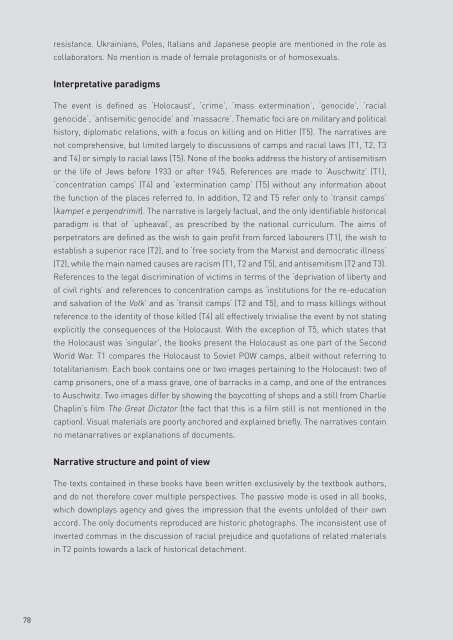228776e
228776e
228776e
You also want an ePaper? Increase the reach of your titles
YUMPU automatically turns print PDFs into web optimized ePapers that Google loves.
esistance. Ukrainians, Poles, Italians and Japanese people are mentioned in the role as<br />
collaborators. No mention is made of female protagonists or of homosexuals.<br />
Interpretative paradigms<br />
The event is defined as ‘Holocaust’, ‘crime’, ‘mass extermination’, ‘genocide’, ‘racial<br />
genocide’, ‘antisemitic genocide’ and ‘massacre’. Thematic foci are on military and political<br />
history, diplomatic relations, with a focus on killing and on Hitler (T5). The narratives are<br />
not comprehensive, but limited largely to discussions of camps and racial laws (T1, T2, T3<br />
and T4) or simply to racial laws (T5). None of the books address the history of antisemitism<br />
or the life of Jews before 1933 or after 1945. References are made to ‘Auschwitz’ (T1),<br />
‘concentration camps’ (T4) and ‘extermination camp’ (T5) without any information about<br />
the function of the places referred to. In addition, T2 and T5 refer only to ‘transit camps’<br />
(kampet e perqendrimit). The narrative is largely factual, and the only identifiable historical<br />
paradigm is that of ‘upheaval’, as prescribed by the national curriculum. The aims of<br />
perpetrators are defined as the wish to gain profit from forced labourers (T1), the wish to<br />
establish a superior race (T2), and to ‘free society from the Marxist and democratic illness’<br />
(T2), while the main named causes are racism (T1, T2 and T5), and antisemitism (T2 and T3).<br />
References to the legal discrimination of victims in terms of the ‘deprivation of liberty and<br />
of civil rights’ and references to concentration camps as ‘institutions for the re-education<br />
and salvation of the Volk’ and as ‘transit camps’ (T2 and T5), and to mass killings without<br />
reference to the identity of those killed (T4) all effectively trivialise the event by not stating<br />
explicitly the consequences of the Holocaust. With the exception of T5, which states that<br />
the Holocaust was ‘singular’, the books present the Holocaust as one part of the Second<br />
World War. T1 compares the Holocaust to Soviet POW camps, albeit without referring to<br />
totalitarianism. Each book contains one or two images pertaining to the Holocaust: two of<br />
camp prisoners, one of a mass grave, one of barracks in a camp, and one of the entrances<br />
to Auschwitz. Two images differ by showing the boycotting of shops and a still from Charlie<br />
Chaplin’s film The Great Dictator (the fact that this is a film still is not mentioned in the<br />
caption). Visual materials are poorly anchored and explained briefly. The narratives contain<br />
no metanarratives or explanations of documents.<br />
Narrative structure and point of view<br />
The texts contained in these books have been written exclusively by the textbook authors,<br />
and do not therefore cover multiple perspectives. The passive mode is used in all books,<br />
which downplays agency and gives the impression that the events unfolded of their own<br />
accord. The only documents reproduced are historic photographs. The inconsistent use of<br />
inverted commas in the discussion of racial prejudice and quotations of related materials<br />
in T2 points towards a lack of historical detachment.<br />
78




